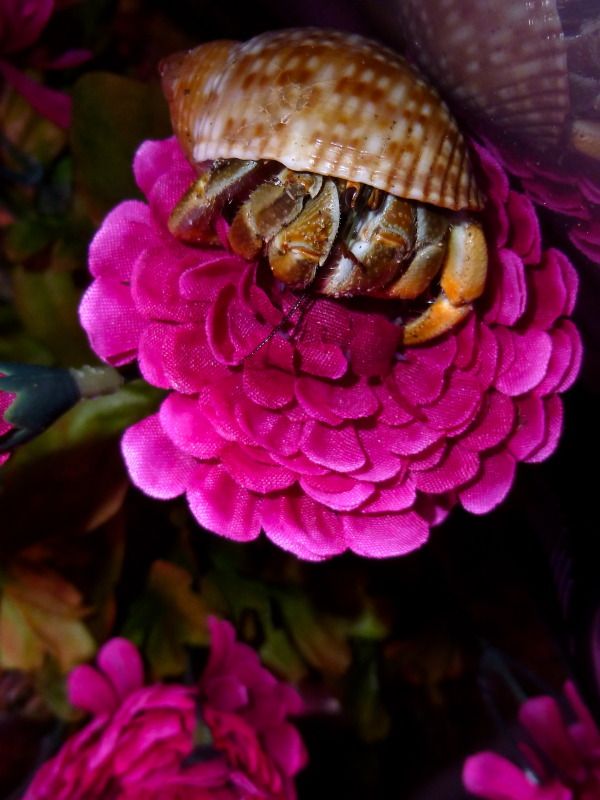I think this is great advice but it raises a point of concern for me. The idea behind bathing a naked hermit crab-- to whatever extent has worked best for you-- should be done with the delicacy of the hermit crab and its abdomen in mind.
As all of us know, the hermit crab's abdomen is the most vulnerable part of the body. Specifically, I want to point out that the abdomen is one of the few places on a hermit's body that can lose water quickly through the skin.
When we bathe a hermit crab, and more specifically put the water on its abdomen, we should consider the natural salinity of the crab's body and our first focus should be maintaining this salinity. You know how when you go in the pool and your fingers get pruny? This is because the pool water has less salts in it than the water that is in your skin. In other words, your body's salinity is hypertonic to the salinity of the pool water. Water from the pool rushes into your cells and dilutes the salts, causing some of the cells to burst and others to swell into "prune fingers."
Osmotic Pressure and the Hermit Crab
What is osmotic pressure and how does it relate to naked hermit crabs? Osmotic pressure is the pressure needed before water is able to flow through a permissible membrane. Pool water steals the dissolved salts from your fingers and causes your individual cells to swell up because everything in nature wants to have the same amount of salts on both sides of any membrane. If there is a gradient, or more salt on one side and less on the other, the water present will change sides until both concentrations are equal.
When we talk about giving a naked hermit crab a bath, we should consider the difference between dechlorinated water, the water inside a hermit crab's body, and our own salt water mixes. If we bathe a hermit crab's abdomen in regular dechlorinated water, the tendency will be for water to rush into the crab's abdomen, diluting out the vital salts its body has retained in order to survive. If we bathe a crab in properly mixed seawater, then water will rush out of the crab's abdomen, dehydrating the hermit crab. The following picture (from Wikipedia) is an example of the same concept using red blood cells as the media. See how in the first instance, the (relatively) low-salt cells are placed in a high-salt solution, which robs the cells of their water. The second instance depicts an isotonic solution, where there is no deadly water movement. The third group has been placed in a solution with more water outside the cells than in, causing the water to rush in and burst (kill) the cells.

Why does this matter? The hermit crab is only in the water for a few seconds to a few minutes. Who cares if the rinse doesn't contain the right amount of salts?
It matters because osmotic pressure regulation (the movement of water either in or out of the cells) is instant. The channel by which water moves in and out of animals' cells is not regulated, nor does it require energy to use. It happens instantaneously. Have you ever washed your hands for a few seconds too long and noticed them already getting pruny? A hermit crab's abdomen is about the size of your finger or less. If their abdomen "gets pruny" from water loss, this is an almost certain death. Death from dehydration occurs after 10 - 15% of water is lost. To give you an idea, a fully grown Ecuadorian crab weighing one ounce (sans shell) can die after losing just 2.5 mL of water (half a teaspoon).
How Can We Help Prevent This?
I propose we revamp how we look at bathing naked hermit crabs. Isotonic saline (salt water that contains the same amount of salt as a living animal's body) has an NaCl concentration of 0.85% to 0.9%. In contrast, we mix our hermit crabs' saltwater to be about 3.5% NaCl, the perfect amount to mimic the ocean.
That's good news, however! In order to make up an isotonic salt water mixture, all we have to do is mix our salt water at 1/4 the strength we use in our salt water bowls. So, if you put one tablespoon of salt per one cup of dechlorinated water, you need to add 1/4 tablespoon per cup. This makes up a mixture of 0.875% saline-- right where it needs to be.
An added benefit to this is bathing a naked hermit crab in isotonic saline gives the abdomen the potential to even out its water concentration. A naked hermit crab becomes dehydrated quickly, and bathing the crab in a solution containing the exact amount of water it needs will allow a proper amount of water to flow into the abdomen without causing any kind of deadly cell lysis (bursting).
This may seem like such a small issue, but I argue that it's one of the most critical steps in caring for a naked crab. No living thing can survive without water, and too much water is just as deadly as too little. This short, five-minute change in how we approach naked hermit crabs can potentially save more of our little guys and ensure more happy years with our hermies.
Sources:
http://en.wikipedia.org/wiki/Osmotic_pressure
http://www.petplace.com/reptiles/choosi ... page1.aspx
http://www.onr.navy.mil/Focus/ocean/water/salinity1.htm
http://www.emc.maricopa.edu/faculty/far ... ransp.html
Class lectures: Small Animal Diseases, Biochemistry, and Microbiology
